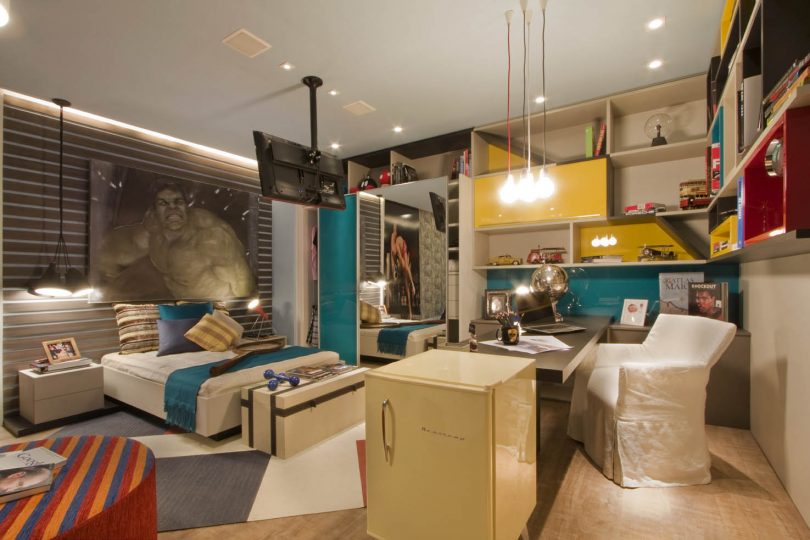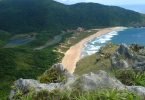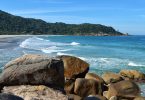If you are in São Paulo and would like to do a short trip, we are creating a lot of thematic tours! This one is the Free Tour São Paulo – Creative City.
São Paulo, the Brazilian city where everything takes place, can be considered an important laboratory of great ideas. The creativity is irradiated in all corners of the city and in mega events like the Virada Cultural [Cultural Marathon] and the São Paulo Fashion Week. A recent research, conducted by the São Paulo City Hall, points out that the creative economy (a group of sectors like design, fashion, culture, technology, arts, etc.) moves about 40 billion reais [T.N. Brazilian currency Real, pl. Reais] a year – 10% of the city’s GIP [gross internal product]. The large number of cultural attractions spread throughout the city, revitalized and reinvented areas, and their connections make São Paulo a Creative City. City where the search for day to day solutions for improvement of the quality of life of its residents and consequently, of its visitors’ delightful stay, is constant. City that stimulates social encounters through events in street, squares and parks. City of cultural effervescence, which preserves its history and values the identity of its people. São Paulo City Hall, through São Paulo Tourism, developed this itinerary with the intention of revealing the innovative spirit of this metropolis even for visitors that have less time to get to know the capital city of São Paulo. Take advantage of every moment in São Paulo, experience creativity in some of the selected attractions in the suggestion that follows and enjoy this Creative City!
Click in the Title of the landmarks for more information.
01 – Vila Madalena neighborhood – Bohemian culture and art
The district of Vila Madalena can be considered an example of creative economy, because it concentrates artists and craftsmen, bookstores, art galleries and an expansive variety of bars and restaurants. The mark of its cultural and intellectual characteristic started between the 1970’s and 1980’s when students of the Universidade de São Paulo [University of São Paulo] installed themselves in the district due to location and to low cost during that time. And thus the number of intellectuals, journalists, musicians and artists was increasing, which brought with them establishments tied with arts like workshops and film producers, aside from an intense night life. With vast commercial, cultural and gastronomical offering during the day and night, “the Vila”, as it is called, is also known for the variety of bars with abundant music and entertainment. During the year, there are even cultural events like Arte da Vila, held in April, where artists of diverse moralities open their workshops, normally closed for visitation, to the public; and the Vila’s Fair, which takes place in August at the blocks between Mourato Coelho, Fidalga, Purpurina and Aspicuelta streets, where approximately 600 exhibitors sell their products, generally, handicrafts.
Getting There: Vila Madalena Metro Station (Green Line) or Fradique Coutinho Metro Station (Yellow Line)
02 – Catavento Cultural
Created in 2009 with the objective of presenting knowledge related to science and to the environment, Catavento Cultural was converted into one of the most visited museums of the country. Making use of a lot of technology, it invests in interactivity with the visitor in its four sections: Universe, Life, Ingenuity and Society. It occupies the Palace of Industries, a huge palace of medieval inspiration built between 1913 and 1924 to be a center of exhibits, however in the course of its history it went through different uses, like police station, Legislative Assembly and seat of São Paulo City Hall. The choice of the building for installation of the museum is not due solely to its beauty and symbolism, but also due to the intention of attracting the population to currently degraded region of Dom Pedro II Park, thus seeking to consist of the site’s development agent.
Where: Praça Cívica Ulisses Guimarães, s/n. Palácio das Indústrias – Parque Dom Pedro II
When: Tuesday to Sunday and holidays from 9 am to 5 pm.
02 – Museu do Futebol – Soccer Museum
A museum that tells how the history of soccer is part of Brazilians’ life could not be well located than under the bleachers of the most traditional São Paulo stadium. Inaugurated in 1940 as the largest stadium in Brazil, Pacaembu (officially called Paulo Machado de Carvalho City Stadium) vibrates with the passion of fans on match days, with the huge number of visitors attracted by the Football Museum on other days. Opened in 2008, the museum makes use of a lot of interactivity and large multimedia collection, and is today one of the greatest tourist attractions of the city.
Where: Praça Charles Miler, s/n – Pacaembu
When: Tuesday to Sunday and holidays from 9 am to 5 pm.
03 – Culture places side by side
Through the cultural use, this important place in downtown is returned to the public. With a modern proposal, the Casa da Imagem [Image House] is the new institution devoted to the photographic memory of São Paulo. In addition to hosting a collection of 710,000 photographs and promote its preservation, research and dissemination, also develops actions aimed at the memory of the documentary image of the city. Occupies the Casa Nº1 [House No. 1], construction of the second half of the nineteenth century that had several uses, and also manages the neighbor Beco do Pinto [Pinto Alley], a passage formerly used for transit of people and animals between the Sé Cathedral and River Tamanduateí floodplain, that today exposes contemporary art projects designed specifically for the space. Recently restored, the Solar of Santos Marquise completes this trio. Remnant of the urban residential architecture of the 18th century, this building is the headquarters of the Museu da Cidade de São Paulo [Museum of the City of São Paulo]. This complex represents a new architectural, historical and cultural reference place in the city.
Casa da Imagem
Where: R. Roberto Simonsen, 136-B Downtown
When: Research on the collection: Tuesday to Friday from 9 am to 5 pm.
Beco do Pinto
Where: R. Roberto Simonsen, s/n
Solar da Marquesa de Santos
Where: R. Roberto Simonsen, 136
When: Tuesday to Sunday from 9 am to 5 pm
04 – Ruth Cardoso Youth Cultural Centre
The Ruth Cardoso Youth Cultural Center – CCJ, equipment of the Municipal Secretary of Culture, is in an area of 8,000 square meters in the Vila Nova Cachoeirinha district, northern zone of the city. The construction of CCJ started off from the reform of a structure once destined to shelter a “sacolão” [wholesale fruit and vegetable market]. Its programming has a vast range of activities directed towards the young public, including courses and workshops, meetings, performances and shows. The themes revolve around current cultural issues, circus, literary, graphic, audiovisual and musical arts, aside from dance and theater. A space where energy and creativity vibrate, and where young people meet to debate, feed themselves with art and produce it, in its most diverse forms.
Where: Av. Deputado Emílio Carlos, 3.641. Vila Nova Cachoeirinha.
When: Tuesday to Saturday, from 10 am to 8 pm; Sunday and holidays, from 10 am to 6 pm
05 – Brazilian Film Library
A former herd slaughterhouse, built in 1887, today shelters the largest collection of images in movement in Latin America. Originated from the creation of the São Paulo Film Club in 1940, the Cinemateca Brasileira [Brazilian Film Library] has a Research and Documentation Center about the theme, Restoration Laboratory and over 200 thousand rolls of films, which correspond to 30 thousand titles between full-length and short films. Films and videos are incorporated in their majority, through donation. They are national and foreign works of fiction, documentaries, newsreels, publicity films and family records, produced since 1895. Meanwhile, the Brazilian Film Library goes beyond keeping the memory: with exhibitory spaces and two modern projection rooms it is also an active cultural center that promotes exhibits and festivals of rare films, contributing to diffusion and cinematographic education of São Paulo residents.
Where: Largo Senador Raul Cardoso, 207-Vila Clementino
When: Monday to Friday from 9 am to 5 pm; Saturday and Sunday in accordance with the schedule
06 – Institution of cultural and educative character
SESC – Serviço Social do Comércio [Commerce Social Service] is an institution of cultural and educative character that exists since 1946, offering diverse activities for the population and visitors throughout Brazil. In 1982, the multifaceted and innovative unit of the Pompéia district was inaugurated. In a then abandoned drum factory, with total area of 23.5 thousand m², the Italian-Brazilian architect Lina Bo Bardi (whose most famous work is the MASP – Museum of Art of São Paulo) implanted a space for leisure and culture that gathers together theaters, courts and multisport gymnasiums, swimming pool, restaurant, exhibitory spaces, draft beer bar, coffee bar, workshops, library, reading room, photographic laboratory, gymnastics rooms, dental consultation room and huge Brazilian and international music shows. All this without losing the rusticity and other characteristics of original use. With almost 20 units in the capital city of São Paulo, SESC has as practice the creation of cultural centers in different regions of the city, thus contributing with the decentralization of São Paulo cultural offering and introducing itself as urban requalification and democratization agent of cultural and leisure offering. Among various examples, SESC Belenzinho is the largest among its units, inaugurated in 2010 and expanded these options in the city’s Eastern Zone.
Where: R. Clélia, 93 – Perdizes
When: Tuesday to Saturday from 9 am to 10 pm; Sunday and holiday from 9 am to 8 pm.
07 – Juventude Park
What was already considered as the largest prison in Latin America, with more than 8 thousand detainees, it is today a 240 thousand m² creative cultural complex. The Parque da Juventude [Youth Park], inaugurated in 2003 in area formerly occupied by the famous Carandiru Penitentiary, is divided into 3 large spaces: the Sports Park, Central Park and Institutional Park. At the site it is possible to see structures of the former prison, preserved for public visitation. The structure of the park has 10 multisport courts, skating ring, 95 thousand m² of green area, besides a 16 thousand m² of Atlantic Forest reserve. An intense schedule of activities and shows is offered to the public. A highlight is the São Paulo Library – one of the main and most modern libraries of the city, with the innovative concept of “Live Library”, in which the focus is not in rarities or great classics, but rather in motivating frequenters to come in contact with different readings, in an open, comfortable and playful environment. Combining a wide repertory of languages like literature, poetry, informatics and arts in general, the rule is to promote inclusion in reading for all publics.
Where: Av. Zaki Narchi, 1309 – Santana
When: Daily from 6 am to 8 pm
08 – Praça Victor Civita – Victor Civita Square
With the name of “Open Space of Sustainability”, the Praça Victor Civita [Victor Civita Square] is result of a public-private partnership that converted a contaminated land where formerly used to operate the Pinheiros Incinerator– which from 1949 to 1989 used to burn about 200 tons of garbage a day – in a exemplary public space. After an area recovery plan, with innovative architectonic project and avant-garde solutions in sustainable construction, Praça Victor Civita offers to the public, for free, broad cultural, sportive, leisure and environmental education program. Its legalized wooden deck, spread throughout the entire square, not only offers a strolling lane and gymnastic equipment, but also allows the use of the space to avoid contact of frequenters with the contaminated soil. Its more than 13 thousand m² also has stage and bleacher for 400 people, diverse equipment and examples of plantations, besides the building of the former Pinheiros incinerator, also recovered, opened to receive exhibits and events. The program of activities is intense and always refers to environmental education.
Where: R. do Sumidouro, 580 – Pinheiros
When: Daily from 6:30 am to 7 pm.
09 – MAAU (Urban Art Open Air Museum)
São Paulo is one of the world capitals of graffiti, and proves this upon transforming a whole region into an open air gallery. Tens of columns that sustain the subway at Avenida Cruzeiro do Sul, from the Estação Tietê [Tietê Station] (where the main bus terminal of the city is), passing through the Estação Carandiru [Carandiru Station] (beside the Youth Park) and extending itself all the way to Estação Santana [Santana Station], gained a special color with the implantation of the 1st Open Urban Art Museum. The idea came up after some artists have been imprisoned in this same region for painting graffiti with no authorization, which generated a class mobilization that resulted into the MAAU project, developed by artists Binho Ribeiro and Chivitz. In partnership with the public power, the initiative was implanted, turning the region merrier and full of life: aside from almost 70 panels painted by around 50 artists (which must be renewed annually to provide opportunity to new names), the space also invests in educative actions with the local population and in the education of the public, favoring the valuation of graffiti as popular art.
Where: Av. Cruzeiro do Sul at the columns that sustain the subway, between the Portuguesa-Tietê and Santana stations.
10 – Bohemian and cosmopolitan region
One of the best examples of the city’s transforming energy. Less than 10 years ago practically restricted to the decadence of nightspots intended to the adult public, the so-called Baixo Augusta – section of Rua Augusta and proximities that goes from Avenida Paulista up to the Praça Roosevelt [Roosevelt Square] – is today one of the most effervescent areas of the metropolis. Bohemian and cosmopolitan region that is a display window of the more modern face of São Paulo and has as synthesis the highly enriched human, commercial and cultural diversity. Inviting area to walk on foot, every unveiled secret on its sidewalks is a separate chapter: street artists, stores that sell secondhand books and bookstores; street movies specialized in the so-called art films; 24 hour bakeries that are real gastronomic temples; discotheques that go from live presentations of the best bands of the new Brazilian musical scene to electronic music clubs that operate after dawn; specialized stage shows, from music to stand up comedy; restaurants and segmented diners like hamburger houses, temaki houses, kebab houses or focused on culinary of the more different nationalities, from Indian to Spanish, passing through North Africa; bars that go from the typical pubs to those that operate in theaters of renowned companies that produce their own plays; certainly, besides some of the oldest remain – ing nightspots. All this filled by a huge diversity of urban groups, crowned for being a world class gay-friendly region, thus producing a melting pot that could only exist in São Paulo.
Where: Rua Augusta (between Avenida Paulista and Roosevelt Square)
11 – The address of famous restaurants
Example of public space reinvented through the entrepreneurship of São Paulo’s private sector, Avanhandava is a traditional address of famous restaurants that passed through an almost two year reform, concluded in 2007. Fruit of a partnership between the public power and the Association of Restaurants of Rua Avanhandava, the intervention implanted urban improvements, widening of sidewalks and installation of fountains and portal that gave the road an atmosphere of a boulevard. With the project, the flow of visitors increased and new bars, restaurants and other establishments inspired in the artistic and bohemian character of the street were installed, turning it into an important gastronomy and leisure center of São Paulo.
Where: In between the streets Martins Fontes and Martinho Prado.
12 – One of the city´s most famous postcards
A perfect venue to encounter city residents in the characteristic coming and going of São Paulo is without doubt Avenida Paulista, one of the city´s most famous postcards. The cosmopolitan image composed of the large road, its high and modern commercial buildings and the intense flow of people 24 hours a day is one of the most famous pictures of the city that does not cease. At the same time, Paulista is an avenue where culture vibrates at every corner, whether in presentations of street artists, or in the exquisite architecture of MASP (São Paulo Art Museum) and its very rich collection, or even in the cultural spaces that are spread from end to end. There are an Antiques Fair on Sundays at the MASP free spam.
Democratic, Paulista, as it is lovingly called by city residents, is also place where large events take place, like the New Year’s Eve celebration and the LGBT Parade, and keeps some surprises, like Trianon Park, Casa das Rosas and Conjunto Nacional.
The Conjunto Nacional is Residential, commercial and cultural building designed by the architect David Libeskind and inaugurated in 1958, in the presence of former president Juscelino Kubitschek, was considered as the first shopping mall of Latin America and the largest in South America. Besides residences, offices, commerce and gymnasium, it also shelters, in the large gallery that gives access to two of the main roads of the city – Rua Augusta and Avenida Paulista – excellent gastronomic and cultural options.
Immerse yourself in the crowd, watch the people, let yourself be carried away by the dynamism and the culture surrounding the most “paulistana”of the avenues.
Where: Av Paulista
13 – Ibirapuera Park – Culture and health
At the Ibirapuera Park, pants, skirts, shirts and dress shoes give room to light clothes and steps and breathing gain new rhythms. In the immense area of over 1.5 million m² known as the beach of São Paulo residents, nature and culture meet each other. There the exuberant green vegetation, architectonic lines of master Oscar Niemeyer, arts and practice of sport and playful activities live together harmoniously. The park is also stage of great events, like São Paulo Fashion Week and music festivals. A place that gains life with people from all ages that frequent it to exercise, watch a musical show or appreciate some exhibit that cannot be missed, to date, to play or to rest. São Paulo is found at the Ibirapuera Park!
In the Ibirapuera Park there are Museum of Modern Art – Mam, Afro Brazil Museum, Ciccillo Matarazzo Pavilion (Bienal Pavilion) , Japanese Pavilion, Ibirapuera Auditorium, Pavilion of Brazilian Cultures, Planetarium, Manequinho Lopes Vivarium and USP Museum of Contemporary Art.
Where: Av. Pedro Álvares Cabral – Moema
When: Daily from 5 am to 12 am.
14 – Mercado Municipal – Municipal Market
A sensorial experience can be lived at the Municipal Market of São Paulo, the famous “Mercadão”, a place already consecrated both as shopping venue and place to stroll and certain presence in the itinerary of any tourist that visits the city. Located in a very beautiful historical building of 1933, designed by the office of the architect Ramos de Azevedo, the building is ornamented with the dazzling stained glass windows of the artist Conrado Sorgenicht Filho. There you could walk through the corridors bursting with colors that fill the eyes and aromas that instigate the taste, to see, to touch and to try the most varied fruits and vegetables, legumes, grains, to listen to traders and their creative and entertaining ways of approaching potential customers, endowing part of the gastronomic diversity of São Paulo, also expressed in the infinity of ingredients and, certainly, to taste delicacies that already form part of city tradition, like the exuberant bologna sandwich and the savory cod pastry
Where: R. da Cantareira, 306 – Sé
When: Monday to Saturday from 6 am to 6 pm; Sunday and holiday from 6 am to 4 pm.
15 – Open Market
Do not miss the opportunity of having a similar experience, but at the streets, in open air, in one of the street markets that take place once a week in almost all districts of the city. One of the largest and most renowned is the Fair which takes place on Tuesdays, Thursdays and Saturdays at the Charles Miller Square, at Pacaembu neighborhood. Try the classic combination of a sugarcane juice accompanied by a pastry at the end of your stroll!
16 – Benedito Calixto all-day market on Saturdays
Definite program of city residents and also tourists, the Fair that takes place on Saturdays at the Benedito Calixto Square since 1987 attracts the most diverse publics, which head there in search of antiquities and trends of varied and creative handicrafts, design, fasionable clothes, gastronomy, music – in the afternoon presentations of Chorinho take place – and people. Among over 300 exhibitors, the climate is of encounters and smiles. The stores, bars and restaurants that surround the square are also introduced in this melting pot, integrating themselves to the fair and attracting their frequenters.
Where: Praça Benedito Calixto – Pinheiros
When: Fair: Saturdays, from 9 am to 7 pm
17 – São Paulo Cultural Center
The São Paulo Cultural Center – CCSP stands out in the urban landscape for its horizontal structure introduced in a solidly verticalized region. The democratic and diversified character is mark of CCSP since its inauguration in 1982. The architectonic proposal for the place sought to value the spaces directed towards cohabitation and multidisciplinarity, which resulted into a cultural center with always pulsating public. The most varied cultural activities are offered in its outbuildings for free or at popular prices. The frequenters of CCSP find there shows of important names from music, theater, movie, literature, dance, exhibits, lectures, aside from some libraries – among which one is directed towards the public with special visual needs and a comics library. The Cultural Center even keeps a vast collection composed of documents and audiovisual material, highlighting here the Oneyda Alvarenga Record Library, which conserves priceless materials registered by the Mission of Folkloric Researches, idealized by Mário de Andrade and conducted in 1938.
Where: R. Vergueiro, 1000 – Paraíso
When: Tuesday to Friday, from 10 am to 8 pm; Saturday, Sunday and holiday from 10 am to 6 pm
18 – Music gallery
Galeria do Rock, is one of these spaces where the gigantic diversity of urban types of São Paulo is wide open. In its more than 450 commercial points, a huge range of styles and trends is identified both of public profile and services offered in this real cultural hub that has 3 concepts as basis: art, music and attitude. A vanguard environment is breathed, fruit of coexistence among so different group that maintains the place as a reference of São Paulo street culture. Receiving more than 20 thousand visitors a day, it is always bursting with young people and old frequenters that make its corridors vibrate since its inauguration in 1963.
Where: Av. São João, 439 – República
When: Monday to Friday, from 9 am to 8 pm; Saturday from 9 am to 5 pm.
19 – Tomie Ohtake Institute – bring new trends of world contemporary art
The building designed by the architect Ruy Ohtake has modern and bold design, with its mauve-colored glasses and curved facade. Within this business complex, the Tomie Ohtake Institute is installed, cultural center created in 2001 to preserve the artistic references of the last 50 years, including the works of the Nippon-Brazilian fine artist Tomie Ohtake, and to also bring new trends of world contemporary art. It has seven rooms for exhibits, an educative sector with four ateliers, space for seminars, besides restaurant, bookstore and store of objects of art and design. Recently embedded to the Complex, Geo Theatre was designed for the public to stay closer to the artists. It was prepared to host large national and international productions. Above all this, it is a great example of the city’s contemporary conception, which integrates culture, work and leisure.
Where: Rua dos Coropés, 88 – Pinheiros
When: Tuesday to Sunday from 11 am to 8 pm.
20 – Cidade Universitária – Various museums with rich and unique collections
The Cidade Universitária Armando de Salles Oliveira [Armando de Salles Oliveira University Campus], USP – Universidade de São Paulo [University of São Paulo] – campus, situated in the Butantã district, is an internationally renowned production hub of knowledge. The USP central administrative structure, Housing Development, Sports Practice Center and practically all teaching units of the university that remained in 13th place world – wide (7th among the teach – ing institutions) in scientific research based on the SIR (Scimago Institutions Ranking) ranking, are located there. With a vast green area, the Cidade Universitária [University campus] also counts on various museums with rich and unique collections, among which are the Museum of Contemporary Art – MAC, Museum of Archaeology and Ethnology – MAE, Museum of Geo sciences and Oceanographic Museum, aside from the Paço das Artes, an active cultural space.
Where: Main Gate (P1): crossing of Av. Afrânio Peixoto with Rua Alvarenga.
When: Monday to Friday: access released from 5 am to 8 pm. Saturdays: access released from 5 am to 2 pm
21 – The city’s best and most famous brands in the field of decoration
Renowned street that concentrates the city’s best and most famous brands in the field of decoration. The space is contended by all kinds of stores: from furniture and objects to doors, panels, electric appliances, kitchens, lighting, carpets and everything that one may need or desire to transform a domestic space into a coveted environment worthy of the most renowned decoration magazines. One can find from excellent products without a known brand to objects of desire with signature of famous personalities like the Campana Brothers. The street received this name in tribute to the illustrious lawyer and politician who resided on it. The place is usually stage for events, like Gabriel 470: Street Art and Avant Gabriel Chandon.
Where: Starts at Av. Rebouças and ends at Marginal Pinheiros
When: Monday to Friday, from 10 am to 7 pm; Saturday up to 2 pm (some up to 6 pm).
22 – Cultural Marathon
A unique, impressing, teeming event: thus the Virada Cultural [Cultural Marathon] is. Urban spaces gain new faces, are transformed into stages through where art lines up in all its forms. Hundreds of musical, theatrical, circus attractions, among many others, are seen simultaneously for 24 uninterrupted hours, at various points of the city, attracting crowds of all tastes and styles that occupy streets, squares and cultural spaces with the objective of having fun and living a different experience. The Vale do Anhangabaú taken by people that appreciate a dance performance accompanied by classical music, the crowd singing in chorus together with its preferred musicians at São João Avenue, the unceasing movement in the subway in the wee hours of the morning. These are some memorable scenes that make the Virada an already consecrated event and waited for with expectation, which attracts about 4 million people in every edition.
Where: It takes place in the whole city
When: May
23 – Sâo Paulo Art Biennial
Bienal de São Paulo is the country’s most important contemporary art exhibit, which is considered as the second mega contemporary art exhibit in the world and the first in the southern hemisphere. Since 1951, it plays an important role in the development of Brazilian visual arts. Bienal gathers together productions of Brazilian and foreign artists, allowing the public to have contact with diverse kinds of arts: visual, scenic, graphic, music, cinema, architecture and others. Tens of Bienals have been held, which had the participation of over 13 thousand artists from 159 countries, with about 60 thousand works exhibited to approximately 7 million visitors.
Where: Pavilhão Ciccillo Matarazzo. Parque do Ibirapuera, Gate 3
When: September to December
24 – Sâo Paulo International Film Festival
Created in 1977 by Leon Cakoff, the Mostra Internacional de Cinema [São Paulo International Film Festival] is Brazil’s first grand international film festival. It lasts for two weeks with approximately 300 films of various kinds and nationalities, exhibited in over 20 places spread throughout the city, among movie theaters, cultural centers and museums. Another film festival that keeps growing every year is the Mix Brazil Festival. It was created with the objective of opening space for cultural diversity.
When: October
25 – São Paulo Fashion Week
São Paulo Fashion Week is the most important event of national fashion. Originated in 1996 by São Paulo native, Paulo Borges, it takes place twice a year at the Bienal Pavilion: in January, with the advance presentation of the autumn/ winter collections, and in June, with the spring/ summer collections.
The influential event was consolidated as one of the major fashion weeks of the world and usually launches and celebrates famous Brazilian stylists and models. It also contributed to the professionalization of an immense chain that involves stylists, models, producers, fabric designers, agencies, technicians and industry in general. In the last editions, some stylists innovated by using unused places, among them the Ibirapuera Park itself, the gardens of the Ipiranga Museum and even the Tietê River, as stage for the fashion shows.
Where: Pavilhão Ciccillo Matarazzo – Parque do Ibirapuera, Gate 3
When: January and June
26 – Campus Party
The world’s largest technol – ogy event arrived in Brazil in 2008. Campus Party gath – ers together thousands of people to debate on subjects in the fields of innovation, science, culture and digital entertainment. In the 2012 edition, 7,500 participants went, with hundreds of activities with the objective of sharing knowledge and checking the technological circuit trends.
When: February
27 – SP Art event
SP Arte is the largest con – temporary art fair of Latin America. In its eighth edition, in 2012, it gathered together over 3 thousand works from among 110 national and foreign galleries. The fair attracts from those interested in appreciating modern and contemporary art up to experienced collectors in search of new acquisitions. In this event there is even a space that serves as “cultural laboratory”, so that new professionals may be discovered for the art market.
Where: Pavilhão Ciccillo Matarazzo – Parque do Ibirapuera, Gate 3
When: May
28 – Casa Cor
Casa Cor is the largest architecture and decoration event of the Americas. Conducted in 19 Brazilian capitals, it has São Paulo as the sole seat where the exposition lasts for more than seven weeks. The first edition, in 1987, got to meet a need of the sector in the country and counted on a little over six thousand visitors; today at least 180 thousand people visit the exhibit. Always in search of new trends, the event is focused on innovation and, more re – cently, on sustainability, allying comfort and beauty with functional environments. The 2012 edition has as theme: “Fashion. Style. Technology”, and huge trend in decoration is the inspiration in the fashion world.
Where: Jockey Club de São Paulo – Av. Lineu de Paula Machado, 1.173 Cidade Jardim
When: May to July
Information from website Cidade de São Paulo

























